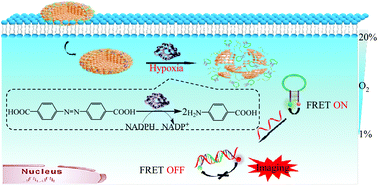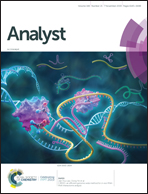A fluorescent nanoprobe based on azoreductase-responsive metal–organic frameworks for imaging VEGF mRNA under hypoxic conditions†
Abstract
As VEGF mRNA is an endothelial cell-specific mitogen and a key regulator of angiogenesis in a variety of physiological and pathological processes, high expression levels of VEGF messenger RNA (mRNA) contribute to VEGF-driven angiogenesis in the hypoxic areas of solid tumors and then disrupt the vascular barrier, which may potentiate tumor cell extravasation. Thus, monitoring the changes in VEGF mRNA is necessary to understand the genetic programme under hypoxic conditions and thus facilitate risk assessment and risk reduction in hypoxic environments. Herein, a new fluorescent nanoprobe based on azoreductase-responsive functional metal–organic frameworks (AMOFs) was developed to realize the imaging of VEGF mRNA under hypoxic conditions. Since the azobenzene units in the AMOFs can be reduced to amines by the highly expressed azoreductase in an oxygen-deficient environment, the VEGF mRNA-targeted molecular beacon (MB), which is adsorbed on the surface of AMOFs via electrostatic interactions, can be released due to the structural damage of AMOFs. Moreover, TAMRA (carboxytetramethylrhodamine, donor) and Cy5 (acceptor) were close to each other due to the stem-loop conformation of MB, thus inducing high fluorescence energy resonance transfer (FRET) efficiency. Upon the addition of VEGF mRNA, the hybridization of VEGF mRNA destroyed the stem-loop conformation of MB, and then, the two fluorophores labeled on MB were separated with low FRET efficiency. This constructed fluorescent nanoprobe enables the quantitative analysis and in situ imaging of the VEGF mRNA level in living cells under hypoxic conditions. We expect that it will offer a potentially rich opportunity to understand the physiological processes of genetic programme.



 Please wait while we load your content...
Please wait while we load your content...